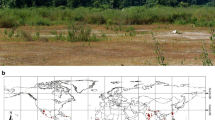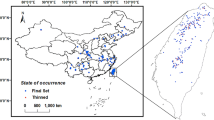Abstract
Understanding the drivers of biological invasions in landscapes is a major goal in invasion ecology. The control of biological invasions has increasingly become critical in the past few decades because invasive species are thought to be a major threat to endemism. In this study, by examining the key variables that influence Acacia mearnsii, we sought to understand its potential invasion in eastern Zimbabwe. We used the maximum entropy (MaxEnt) method against a set of environmental variables to predict the potential invasion front of A. mearnsii. Our study showed that the predictor variables, i.e., aspect, elevation, distance from streams, soil type and distance from the nearest A. mearnsii plantation adequately explained (training AUC = 0.96 and test AUC = 0.93) variability in the spatial distribution of invading A. mearnsii. The front of invasion by A. mearnsii seemed also to occur next to existing A. mearnsii plantations. Results from our study could be useful in identifying priority areas that could be targeted for controlling the spread of A. mearnsii in Zimbabwe and other areas under threat from A. mearnsii invasion. We recommend that the plantation owners pay for the control of A. mearnsii invasion about their plantations.




Similar content being viewed by others

References
Albins MA (2015) Invasive Pacific lionfish Pterois volitans reduce abundance and species richness of native Bahamian coral-reef fishes. Mar Ecol Prog Ser 522:231–243
Armesto JJ, Martinez JA (1978) Relations between vegetation structure and slope aspect in the mediterranean region of Chile. J Ecol 66(3):881–889
Beck SL, Dunlop R, Van Staden J (1998) Rejuvenation and micropropagation of adult Acacia mearnsii using coppice material. Plant Growth Regul 26:149–153
Belnap J, Ludwig JA, Wilcox BP, Betancourt JL, Dean WRJ, Hoffmann BD, Milton SJ (2012) Introduced and invasive species in novel rangeland ecosystems: friends or foes? Rangel Ecol Manag 65:569–578
Boland D (1997) Plantation practices in Zimbabwe, Kenya and Tanzania. Black Wattle and its Utilisation 67
Booth TH, Jovanovic T (1988) Climatology of Acacia mearnsii. 1. Characteristics of natural sites and exotic plantations. New For 2:17–30
Castelli RM, Chambers JC, Tausch RJ (2000) Soil–plant relations along a soil-water gradient in Great Basin riparian meadows. Wetlands 20:251–266
Chan JM, Day P, Feely J, Thompson R, Little KM, Norris CH (2015) Acacia mearnsii industry overview: current status, key research and development issues. South For J For Sci 77:19–30
Child G (2012) The emergency of modern nature conservation in Zimbabwe. In: Child G, Suich H, Anna S (eds) Evolution and innovation in wildlife conservation: parks and game ranches to transfrontier conservation areas. Earthscan, Sterling, VA, pp 67–84
Crous CJ, Jacobs SM, Esler KJ (2012) Drought-tolerance of an invasive alien tree, Acacia mearnsii and two native competitors in fynbos riparian ecotones. Biol Invasions 14:619–631
Dalu T, Sachikonye MT, Alexander ME, Dube T, Froneman WP, Manungo KI, Bepe O, Wasserman RJ (2016) Ecological assessment of two species of Potamonautid freshwater crabs from the eastern highlands of Zimbabwe, with implications for their conservation. PLoS ONE 11:e0145923
DiTomaso JM (2000) Invasive weeds in rangelands: species, impacts, and management. Weed Sci 48:255–265
Elith J, Graham CH (2009) Do they? How do they? Why do they differ? On finding reasons for differing performances of species distribution models. Ecography 32:66–77
Elith J, Graham CH, Anderson RP, Dudík M, Ferrier S, Guisan A, Hijmans RJ, Huettmann F, Leathwick JR, Lehmann A (2006) Novel methods improve prediction of species’ distributions from occurrence data. Ecography 29:129–151
Fuhlendorf SD, Engle DM (2001) Restoring heterogeneity on rangelands: ecosystem management based on evolutionary grazing patterns. Bioscience 51:625–632
Gibson MR, Richardson DM, Marchante E, Marchante H, Rodger JG, Stone GN, Byrne M, Fuentes-Ramírez A, George N, Harris C (2011) Reproductive biology of Australian acacias: important mediator of invasiveness? Divers Distrib 17:911–933
Giljohann KM, Hauser CE, Williams NS, Moore JL (2011) Optimizing invasive species control across space: willow invasion management in the Australian Alps. J Appl Ecol 48:1286–1294
Gormley AM, Forsyth DM, Griffioen P, Lindeman M, Ramsey DS, Scroggie MP, Woodford L (2011) Using presence-only and presence–absence data to estimate the current and potential distributions of established invasive species. J Appl Ecol 48:25–34
Grant J, Moran G, Moncur M (1994) Pollination studies and breeding system in Acacia mearnsii. In: Australian tree species research in China, pp 165–170
Grejner-Brzezinska DA, Phuyal BP (1998) Positioning accuracy of the airborne integrated mapping system. Institute of Navigation, National Technical Meeting ‘Navigation 2000’, Long Beach, CA, pp 713–721
Guisan A, Thuiller W (2005) Predicting species distribution: offering more than simple habitat models. Ecol Lett 8:993–1009
Gurevitch J, Padilla DK (2004) Are invasive species a major cause of extinctions? Trends Ecol Evol 19:470–474
Higgins SI, Richardson DM, Cowling RM, Trinder-Smith TH (1999) Predicting the landscape-scale distribution of alien plants and their threat to plant diversity. Conserv Biol 13:303–313
Holmes P, Cowling R (1997) The effects of invasion by Acacia saligna on the guild structure and regeneration capabilities of South African fynbos shrublands. J App Ecol 34(2):317–332
Huerta MAO, Peterson AT (2008) Modeling ecological niches and predicting geographic distributions: a test of six presence-only methods. Rev Mex Biodivers 1:205–216
ISSG (2017) Global invasive species database. Species Survival Commission: International Union for Conservation of Nature. Accessed 30 May 2017
Kessy B (1986) Growth of Australian acacias in Tanzania. In: Proceedings, international workshop held at Gympie, Australia, pp 123–125
Kulkarni M, Sparg S, Van Staden J (2007) Germination and post-germination response of Acacia seeds to smoke-water and butenolide, a smoke-derived compound. J Arid Environ 69:177–187
Kull CA, Tassin J, Rangan H (2007) Multifunctional, scrubby, and invasive forests? Wattles in the highlands of Madagascar. Mt Res Dev 27:224–231
Kutiel P, Lavee H (1999) Effect of slope aspect on soil and vegetation properties along an aridity transect. Isr J Plant Sci 47:169–178
Laparie M, Renault D, Lebouvier M, Delattre T (2013) Is dispersal promoted at the invasion front? Morphological analysis of a ground beetle invading the Kerguelen Islands, Merizodus soledadinus (Coleoptera, Carabidae). Biol Invasions 15:1641–1648
Leung B, Lodge DM, Finnoff D, Shogren JF, Lewis MA, Lamberti G (2002) An ounce of prevention or a pound of cure: bioeconomic risk analysis of invasive species. Proc R Soc Lond B Biol Sci 269:2407–2413
Luyt I, Mullin L, Gwaze D (1987) Black wattle (Acacia mearnsii) in Zimbabwe. In: TURNBULL, JW Australian acacias in developing countries: proceedings. ACIAR, Camberra, pp 128–131
Mack RN, Simberloff D, Mark Lonsdale W, Evans H, Clout M, Bazzaz FA (2000) Biotic invasions: causes, epidemiology, global consequences, and control. Ecol Appl 10:689–710
Maroyi A (2015) Exotic Acacia species in Zimbabwe: a historical and ecological perspective. Stud Ethno-Med 9:391–399
Matongo V (2016) Trends in spatial distribution of alien woody species and primary production on invaded sites in Nyanga National Park, Zimbabwe. Unpublished thesis
Milton S, Hall A (1981) Reproductive biology of Australian acacias in the south-western Cape Province, South Africa. Trans R Soc S Afr 44:465–487
Mpakairi KS, Ndaimani H, Tagwireyi P, Gara TW, Zvidzai M, Madhlamoto D (2017) Missing in action: species competition is a neglected predictor variable in species distribution modelling. PLoS ONE 12:e0181088
Muneri A (1997) Kraft pulping properties of Acacia mearnsii and Eucalyptus grandis grown in Zimbabwe. South Afr For J 179:13–19
Myers JH, Simberloff D, Kuris AM, Carey JR (2000) Eradication revisited: dealing with exotic species. Trends Ecol Evol 15:316–320
Ndaimani H, Tagwireyi P, Sebele L, Madzikanda H (2016) An ecological paradox: the African wild dog (Lycaon pictus) is not attracted to water points when water is scarce in Hwange National Park, Zimbabwe. PloS One 11:e0146263
Nekola JC, White PS (1999) The distance decay of similarity in biogeography and ecology. J Biogeogr 26:867–878
Nyamapfene KW (1991) The soils of Zimbabwe. Nehanda Publishers, Harare
O’Dowd DJ, Gill AM (1986) Seed dispersal syndromes in Australian Acacia. In: Murray D (ed) Seed dispersal. Academic Press, London, UK, pp 87–121
Olckers T (2004) Targeting emerging weeds for biological control in South Africa: the benefits of halting the spread of alien plants at an early stage of their invasion: working for water. S Afr J Sci 100:64–68
Peterson AT (2003) Predicting the geography of species’ invasions via ecological niche modeling. Q Rev Biol 78:419–433
Peterson AT, Vieglais DA (2001) Predicting species invasions using ecological niche modeling: new approaches from bioinformatics attack a pressing problem. Bioscience 51:363–371
Phillips SJ, Dudík M (2008) Modeling of species distributions with Maxent: new extensions and a comprehensive evaluation. Ecography 31:161–175
Phillips BL, Brown GP, Webb JK, Shine R (2006) Invasion and the evolution of speed in toads. Nature 439:803
Pieterse P, Boucher C (1997) Is burning a standing population of invasive legumes a viable control method? Effects of a wildfire on an Acacia mearnsii population. South Afr For J 180:15–21
Pimm SL, Russell GJ, Gittleman JL, Brooks TM (1995) The future of biodiversity. Science 269:347
Ricciardi A, Steiner WW, Mack RN, Simberloff D (2000) Toward a global information system for invasive species. AIBS Bull 50:239–244
Richardson DM, Kluge RL (2008) Seed banks of invasive Australian Acacia species in South Africa: role in invasiveness and options for management. Perspect Plant Ecol Evol Syst 10:161–177
Rouget M, Richardson DM, Nel JL, Le Maitre DC, Egoh B, Mgidi T (2004) Mapping the potential ranges of major plant invaders in South Africa, Lesotho and Swaziland using climatic suitability. Divers Distrib 10:475–484
Searle S (1997) Acacia mearnsii De Wild. (black wattle) in Australia. Black Wattle and its utilization. Barton, ACT, pp 1–10
Smith CW (1985) Impact of alien plants on Hawaii’s native biota. In: Stone C, Scott JM (eds) Hawaii’s terrestrial ecosystems: preservation and management. CNPRSU, Hawaii, pp 80–250
Soininen J, McDonald R, Hillebrand H (2007) The distance decay of similarity in ecological communities. Ecography 30:3–12
Suich H, Child B, Spenceley A (2012) Evolution and innovation in wildlife conservation: parks and game ranches to transfrontier conservation areas. Earthscan, London
Thuiller W, Georges D, Engler R, Breiner F, Georges MD, Thuiller CW (2016) Package ‘biomod2’
Václavík T, Meentemeyer RK (2012) Equilibrium or not? Modelling potential distribution of invasive species in different stages of invasion. Divers Distrib 18:73–83
Whittaker RH (1967) Gradient analysis of vegetation. Biol Rev 42:207–264
Wilson JR, Gairifo C, Gibson MR, Arianoutsou M, Bakar BB, Baret S, Celesti-Grapow L, DiTomaso JM, Dufour-Dror JM, Kueffer C (2011) Risk assessment, eradication, and biological control: global efforts to limit Australian acacia invasions. Divers Distrib 17:1030–1046
Zisadza-Gandiwa P, Gandiwa E, Matokwe TB, Gwazani R, Mashapa C, Muboko N, Mudangwe S (2014) Preliminary assessment of vegetation fires and their impact in Nyanga National Park, Zimbabwe. Greener J Biol Sci 4:009–017
Acknowledgements
We thank the Zimbabwe National Parks and Wildlife Management Authority for allowing the authors access to Nyanga National Park for purposes of data collection and data validation.
Author information
Authors and Affiliations
Corresponding author
Additional information
Publisher's Note
Springer Nature remains neutral with regard to jurisdictional claims in published maps and institutional affiliations.
Project funding: This research received no external funding.
The online version is available at http://www.springerlink.com.
Corresponding editor: Tao Xu.
Rights and permissions
About this article
Cite this article
Hardlife, M., Henry, N., Paradzayi, T. et al. Predicting the invasion of a southern African savannah by the black wattle (Acacia mearnsii). J. For. Res. 31, 1995–2003 (2020). https://doi.org/10.1007/s11676-019-00975-0
Received:
Accepted:
Published:
Issue Date:
DOI: https://doi.org/10.1007/s11676-019-00975-0



